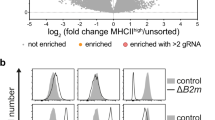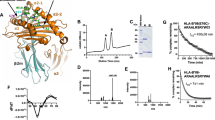Abstract
THE degradation of most cellular proteins starts with their covalent conjugation with ubiquitin1,2. This labels the proteins for rapid hydrolysis to oligopeptides by a (26S) proteolytic complex containing a (20S) degradative particle called the proteasome3,4. Some system in the cytosol also generates antigenic peptides from endogenously synthesized cellular and viral proteins5–10. These peptides bind to newly synthesized class I major histocompatibility complex molecules in the endoplasmic reticulum and peptide/class I complexes are then transported to the cell surface for presentation to cytotoxic T cells11,12. How these peptides are produced is unknown, although a modification that promotes ubiquitin-dependent degradation of a viral protein enhances its presentation with class I13 and indirect evidence suggests a role for proteolytic particles closely resembling and perhaps identical to the proteasome4,12,14,15. Using cells that exhibit a temperature-sensitive defect in ubiquitin conjugation, we report here that nonpermissive temperature inhibited class I-restricted presentation of ovalbumin introduced into the cytosol, but did not affect presentation of an ovalbumin peptide synthesized from a minigene. These results implicate the ubiquitin-dependent proteolytic pathway in the production of antigenic peptides.
This is a preview of subscription content, access via your institution
Access options
Subscribe to this journal
Receive 51 print issues and online access
$199.00 per year
only $3.90 per issue
Buy this article
- Purchase on Springer Link
- Instant access to full article PDF
Prices may be subject to local taxes which are calculated during checkout
Similar content being viewed by others
References
Hershko, A. & Ciechanover, A. A. Rev. Biochem. 61, 761–807 (1992).
Rechsteiner, M. A. Rev. Cell Biol. 3, 1–30 (1987).
Goldberg, A. L. Eur. J. Biochem. 203, 9–23 (1992).
Goldberg, A. L. & Rock, K. L. Nature 357, 375–379 (1992).
Townsend, A. R. M., Gotch, F. M. & Davey, J. Cell 42, 457–467 (1985).
Townsend, A. R. M., Bastin, J., Gould, K. & Brownlee, G. G. Nature 324, 575–577 (1986).
Morrison, L. A. et al. J. exp. Med. 163, 903–921 (1986).
Moore, M. W., Carbone, F. R. & Bevan, M. J. Cell 54, 777–785 (1988).
Spies, T. & Demars, R. Nature 351, 323–324 (1991).
Powis, S. J. et al. Nature 354, 529–531 (1991).
Yewdell, J. W. & Bennink, J. R. Adv. Immun. 52, 1–123 (1992).
Monaco, J. J. Immun. Today 13, 173–179 (1992).
Townsend, A. et al. J. exp. Med. 168, 1211–1224 (1988).
Parham, P. Nature 348, 674–675 (1990).
Yang, Y., Waters, J. B., Fruh, K. & Peterson, P. A. Proc. natn. Acad. Sci. U.S.A. 89, 4928–4932 (1992).
Kulka, R. G. et al. J. biol. Chem. 263, 15726–15731 (1988).
Gropper, R. et al. J. biol. Chem. 266, 3602–3610 (1991).
Rock, K. L., Rothstein, L. & Gamble, S. J. Immun. 145, 804–811 (1990).
Wiley, H. S. & McKinley, D. N. Meth. Enzym. 146, 402–417 (1987).
Falk, K. et al. Nature 351, 290–296 (1991).
Rock, K. L., Rothstein, L. & Benacerraf, B. Proc. natn. Acad. Sci. U.S.A. 89, 8918–8922 (1992).
Townsend, A. et al. Cell 62, 285–295 (1990).
Smith, M. H. & Barber, B. H. Molec. Immun. 27, 169–180 (1990).
Ljunggren, H-G. et al. Nature 346, 476–480 (1990).
Van Pel, A. & Boon, T. Immunogenetics 29, 75–79 (1989).
Henderson, R. A. et al. Science 255, 1264–1266 (1992).
Alexander, J. et al. Immunogenetics 31, 169–178 (1990).
Arnold, D. et al. Nature 360, 171–173 (1992).
Momburg, F. et al. Nature 360, 174–177 (1992).
Michalek, M. T., Benacerraf, B. & Rock, K. L. J. Immun. 146, 449–456 (1991).
Takebe, Y. et al. Molec. cell. Biol. 8, 466–472 (1988).
Siu, G., Hedrick, S. M. M. & Brian, A. A. J. Immun. 143, 3813–3820 (1989).
Dang, L. H. et al. J. Immun. 144, 4082–4091 (1990).
Kohler, G., Fischer-Lindahl, K. & Heusser, C. Immune System 2, 202–208 (1981).
Jones, B. & Janeway, C. A. Jr Nature 292, 547–549 (1981).
Chakrabati, S., Brechling, K. & Moss, B. Molec. cell. Biol. 5, 3403–3409 (1985).
Moss, B. & Earl, P. in Current Protocols in Molecular Biology (eds Ausubel, F. M. et al.) 16.15.1–16.19.9 (Greene-Wiley, New York, 1991).
Author information
Authors and Affiliations
Rights and permissions
About this article
Cite this article
Michalek, M., Grant, E., Gramm, C. et al. A role for the ubiquitin-dependent proteolytic pathway in MHC class l-restricted antigen presentation. Nature 363, 552–554 (1993). https://doi.org/10.1038/363552a0
Received:
Accepted:
Issue Date:
DOI: https://doi.org/10.1038/363552a0
This article is cited by
-
Targeting ubiquitin signaling for cancer immunotherapy
Signal Transduction and Targeted Therapy (2021)
-
HLA class I is most tightly linked to levels of tapasin compared with other antigen-processing proteins in glioblastoma
British Journal of Cancer (2015)
-
Targeting of MYCN by means of DNA vaccination is effective against neuroblastoma in mice
Cancer Immunology, Immunotherapy (2015)
-
The role of ubiquitylation in immune defence and pathogen evasion
Nature Reviews Immunology (2012)
-
Insights into the processing of MHC class I ligands gained from the study of human tumor epitopes
Cellular and Molecular Life Sciences (2011)
Comments
By submitting a comment you agree to abide by our Terms and Community Guidelines. If you find something abusive or that does not comply with our terms or guidelines please flag it as inappropriate.



